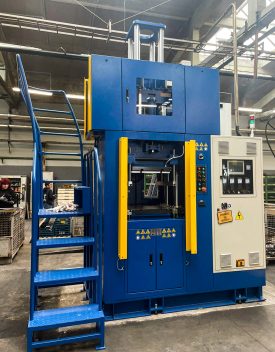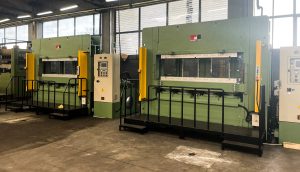Three new presses in Bulgaria
11 January 2023

RIS Bulgaria got the year off to a good start, deploying three new presses delivered shortly before Christmas. These will have been commissioned by the end of the month, greatly increasing the factory’s capacity at one fell swoop.
Capacity will be extended by one injection press, which replaces an obsolete model, and two compression moulding presses. These two presses can handle plate dimensions of 2000 × 500mm, and feature an impressive 600 ton closing force. The presses have been customised so that we can meet the growing demands of our customers in the agricultural industry.
Deployment of compression moulding presses
The new compression moulding presses are long and narrow. We already had six such presses, so with the installation of the two new machines we now have a total of eight. The moulds used for production on these presses have several cavities in order to achieve a high output.
We mainly use this type of press for the production of V-type pintle bars, H-type pintle bars and carriers. This will tell you that we can supply metal bars with rubber components in all manner of executions and designs. These products are further processed by our customers into the comprehensive conveyor belts used in crop-lifting and harvesting machines. With these machines, farmers can harvest potatoes and sugar beet from the land rapidly and efficiently.
These compression moulding presses are also used for the production of long items, such as the axial and radial rollers that are also used in harvesting machines; in short, these presses are suitable for a wide range of applications.

The benefits of rubber products
Rubber is an ideal choice for agricultural machinery because of its resistance to wear. It is also flexible, which means that the potatoes and sugar beet incur minimal damage and remain unblemished during the harvesting process. After all, a potato should look good on your plate too… Tomatoes, carrots and beet are among the other crops which are lifted mechanically from the field, and conveyor belts are also tailor-made for harvesting these using our rubber products. The rubber components of these bars are fitted at the RIS Bulgaria factory.
What is a compression-moulding press?
When using a compression-moulding press, the amount of rubber required is inserted into the mould manually. The press is then closed, applying pressure to the mould. The rubber is vulcanised in the desired configuration and at the correct temperature before the moulded rubber item is removed from the mould, checked, and post-processed if necessary. A multitude of moulded rubber articles can be produced using a compression-moulding press, some in combination with metal.
If you would like to know more about the possibilities, please contact us. We would be delighted to work with you to find a solution.
Let’s make things together!

